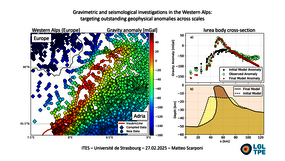Gravimetric and seismological investigations in the Western Alps: targeting outstanding geophysical anomalies across scales
The Western Alps (Europe), and the Ivrea-Verbano Zone in particular (IVZ, Piedmont, Italy), constitute one of the best open-air natural
laboratories for the study of the continental crust, spanning from local (sub-km) to regional (100s of km) spatial scales. The IVZ exposes at the surface an almost unique, and nearly complete, cross-section of the continental crust, ranging from upper-crustal to lower-crustal (and
mantle) composition rocks. Below the surface, both gravimetric and seismological investigations reveal the existence of a dense, fast
structure. This outstanding crustal anomaly extends along the whole arc of the Western Alps, and it is known as the Ivrea Geophysical body
(IGB). Important scientific questions concern the IGB and its relationship to the surface geological observations: what is the link
between the anomalous IGB structure and the surface lower-crustal outcrops? Furthermore, how is the IGB structure and composition changing at depth? New gravimetric and seismic data provide the opportunity for further advances on this topic, via Bouguer gravity, seismic receiver functions and ambient noise analysis and modeling.
Matteo Scarponi, LGL-TPE
27
février 2025
13h
14h
Salle du conseil

